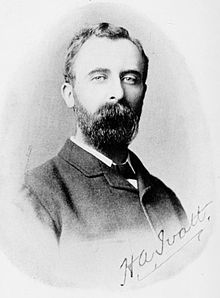Henry A. Ivatt
| Henry Alfred Ivatt | |
|---|---|
 |
|
| Born |
16 September 1851 Wentworth, Cambridgeshire, England |
| Died | 25 October 1923 (aged 72) Haywards Heath, Sussex, England |
| Nationality | British |
| Education | Liverpool College |
| Occupation | Engineer |
| Engineering career | |
| Discipline | Locomotive engineering |
Henry Alfred Ivatt (16 September 1851 – 25 October 1923) was born in Wentworth, Cambridgeshire, England, and was educated at Liverpool College. He became the Chief Mechanical Engineer of the Great Northern Railway from 1896 to 1911.
Aged 17, Ivatt was apprenticed to John Ramsbottom at the Crewe Works of the London and North Western Railway (LNWR). He worked as a fireman for six months and held various positions there. He was made head of the Holyhead Locomotive Depot in 1874, before being promoted to the head of the Chester District.
In 1877, Ivatt moved to Ireland, and the Great Southern and Western Railway at Inchicore. In 1882, he was appointed to the post of locomotive engineer there, where he patented a design for a sprung flap for vertically-opening carriage windows that became ubiquitous.
In 1895, Ivatt returned to England and was appointed Locomotive Superintendent of the Great Northern Railway (GNR), with references from Samuel W. Johnson, John Aspinall, Francis William Webb and William Dean. The man he succeeded was Patrick Stirling.
At the GNR, he became associated with the 4-4-2 (Atlantic) type, which he introduced to Britain. Ivatt was also the first to introduce Walschaerts valve gear to Britain. Ivatt retired on 2 December 1911. He was succeeded as Chief Mechanical Engineer (CME) of the GNR by Nigel Gresley.
...
Wikipedia
